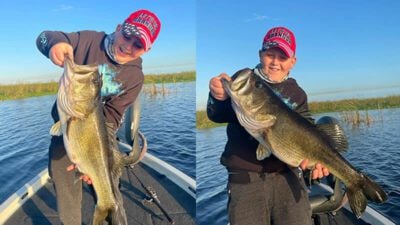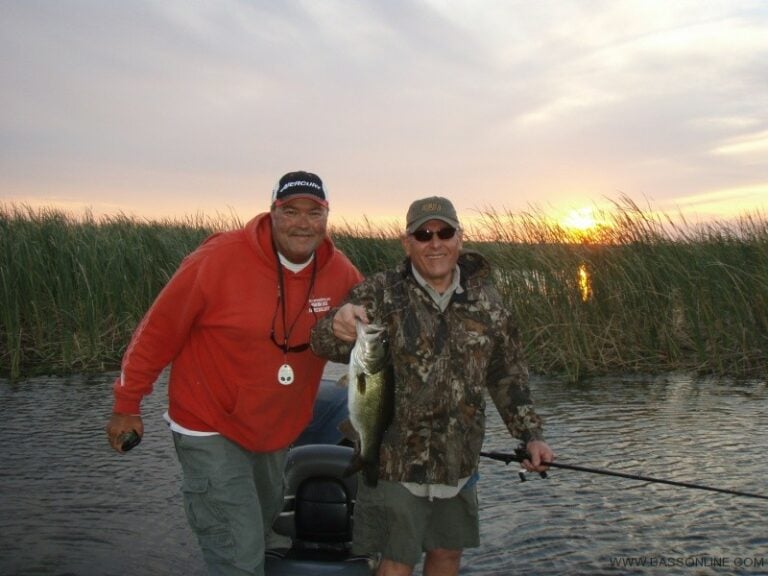Flipping and pitching for bass can transform your fishing experience, tackling the challenges of landing more bass in dense spots. We get how frustrating it can be when those big catches seem elusive.
That’s where our expert guide steps in with techniques proven by seasoned pros.
- Discover flipping and pitching for bass to navigate dense cover effectively.
- Learn why bass prefer specific covers and how to adapt your strategy.
- Select the optimal gear tailored for flipping and pitching success.
Understanding the Importance of Cover in Bass Fishing
 Bass aren’t just meandering about aimlessly in the water—they’re purposefully seeking out cover. Why? Because that’s where they thrive. Cover isn’t just a random choice; it serves as both a defensive stronghold and a hunting ground. Understanding this aspect can revolutionize your approach to bass fishing.
Bass aren’t just meandering about aimlessly in the water—they’re purposefully seeking out cover. Why? Because that’s where they thrive. Cover isn’t just a random choice; it serves as both a defensive stronghold and a hunting ground. Understanding this aspect can revolutionize your approach to bass fishing.
Here’s what you need to know about bass and their love for cover:
- Safety and Ambush: Cover provides safety from predators and allows bass to ambush prey. Structures like submerged logs, overhanging docks, and dense vegetation give bass the perfect hiding spots.
- Stable Environment: Bass experience less current disturbance in these areas, which gives them energy savings—meaning they’re more efficient hunters. They can remain inactive until a meal swims by.
- Oxygen and Temperature: Different covers offer varying levels of oxygen and temperature, keeping bass comfortable. Rocks and aquatic plants can provide cooler refuge in hot weather, while man-made covers like piers might offer warmer hideouts in cooler climates.
Every lake has unique covers, and recognizing these spots can significantly elevate your successful catch rate. So the next time you’re out on the water, focus your efforts where the cover is most appealing.
How to Select the Right Gear for Flipping and Pitching
Choosing the right gear for flipping and pitching isn’t just about getting the best of the best—it’s about the right fit for your fishing scenario and skill level. Tailored gear improves your efficiency and helps tackle different cover challenges. Here’s how to fine-tune your setup:
- Rods: Go for a heavy or extra-heavy rod with fast action. This helps manage the large bass often found in these covered spots and lets you make a clean, quick hook set.
- Reels: A baitcasting reel with a strong drag system ensures you can manage the bass’s fight effectively. It offers better control and precision, which are essential for these techniques.
- Lines: Superior lines are crucial. A braided line (20-50 pound test) provides sensitivity and strength to slice through vegetation without losing the catch.
For novices, mid-tier equipment can provide a good balance to practice without a hefty investment. For seasoned pros, perfect your arsenal with customized gear that meets your specific needs. Personalized gear isn’t just a gimmick—it’s a strategic tool that aligns with your bassin’ style.
Perfecting Your Flipping Technique for Maximum Efficiency
Flipping might seem simple, but when executed with precision, it transforms your catch rate. Here’s how to get it right:
- Start with a short line segment. Hold it in your reel hand. Extend your rod arm smoothly to present the lure to the target without a backward swing.
- Move slowly and steadily. Keep disruptions in the water minimal to avoid spooking the fish. This minimizes visual and auditory alarms for the bass.
- Drop your lure with style. A lightly weighted lure is your friend—it mimics baitfish movements perfectly. Aim for a lifelike presentation as it descends naturally.
Flipping shines in shallow, clear waters. Focus on placing your lure where it’s most effective: right into the bass’s obscured haven. Practice your precision because getting the basics right ensures success.
Mastering the Art of Pitching: Steps and Strategy
 Now, let’s pivot to mastering the art of pitching. When done right, this technique broadens your reach, allowing you to present your lure to distant targets accurately. Here’s how:
Now, let’s pivot to mastering the art of pitching. When done right, this technique broadens your reach, allowing you to present your lure to distant targets accurately. Here’s how:
- Smooth Swing: Use an underhand swing to send your lure toward your target. Hold the lure in one hand and let the rod’s weight do the pitching.
- Optimal Release: Tilt the rod slightly upwards. Release the lure at the swing’s peak to maintain control. Your aim is accuracy, so the softer your landing, the better.
- Dynamic Environment: Pitching thrives when you need that extra distance and precision. You can target deeper waters where flipping might fall short.
Adjusting your technique based on the environment is crucial. Windy conditions or deep water mean pitching outshines flipping. Pivot seamlessly between these techniques as needed, adding the correct value to your bass fishing expertise.
Understanding where and how to best apply flipping and pitching empowers you to tweak your fishing tactics for maximum rewards. It’s not just about quantity; it’s about catching the right fish, at the right moment, in the right way.
Adapting Flipping and Pitching Techniques to Different Water Conditions
Adapting your flipping and pitching game to varying water conditions can make or break your fishing success. Water clarity, temperature, and depth all call for strategic modifications to keep your techniques effective, ensuring you stay ahead of the curve.
Key Adjustments:
- Murky Waters: Opt for vibrant, noise-making baits to grab attention when visibility is low. Lures with built-in rattles work wonders in murky waters to guide bass to your hook.
- Temperature Swings: Cooler temperatures might require slower presentations, while warmer waters benefit from a speedier lure retrieve. The fish’s metabolism changes with temperature, so your strategy should, too.
- Depth Variations: Use heavier weights in deeper waters to ensure your lure reaches the bottom swiftly without wasting valuable time. This is crucial when targeting bass hiding beneath deeper structures.
- Current and Wind: Adjust tackle selections, such as heavier lines, to combat currents or the pull of the wind. This stabilizes your lure’s movement, helping you maintain the desired control.
Remember, the more you understand the interplay between these variables, the more tactical your approach will become. Fine-tuning your tactics based on water conditions puts you at the forefront of the bass fishing game, enabling you to meet any challenge with precision.
Common Mistakes to Avoid When Flipping and Pitching
Even the most experienced anglers can stumble upon errors. Recognizing these pitfalls in flipping and pitching helps you maintain an edge and increases your success rate. Let’s spotlight some common missteps.
- Splashy Entries: Avoid loud splashdowns. They can scare away your target. Practice gentle, precise lure entries to keep your approach quiet.
- Gear Mismatch: Ensure your rods, reels, and lines are synchronized for powerful reeling and effective control. A mismatch can lead to missed catches or losses at critical moments.
- Unnecessary Noise: Stay stealthy. Simple things like excessive movement or boat noise can tip off wary bass. Silence is your companion.
Adaptability reigns supreme here. Sticking rigidly to strategies without observing water and fish behavior can hinder your success. Learn to adjust actively to ensure you’re always in the game. Avoiding these mistakes opens the door to consistently improved outcomes.
Advanced Tips to Elevate Your Flipping and Pitching for Bass Skills
Now that you’ve covered the basics and avoided key mistakes, let’s step it up. Elevate your skills with advanced insights that can refine your technique and push your abilities further.
Up Your Game:
- Weedless Rigging: Integrate soft plastics in complex covers using proper hooks and weights to reduce snags. This requires practice but pays off in untouched locations.
- Scent Addition: Boost your lure’s appeal by adding scent to entice bass more effectively. This can seal the deal when visual cues just aren’t enough.
- Off-Water Practice: Use pitch and flip drills away from water to enhance accuracy. Consistent practice makes in-water execution seamless and second nature.
- Sonar Insights: Leverage sonar technology to pinpoint thriving fishing grounds. Technology simplifies spotting live targets, pairing perfectly with manual prowess.
These tweaks and gear strategies cater to a proactive bass angler. Stretching your technique and your gear’s capabilities redefines success and makes each trip rewarding.
Conclusion
Flipping and pitching redefine your bass fishing experience by bringing you closer to those hard-to-reach catches. Dive into these methods with focus, optimism, and a willingness to adapt, and watch your catch count soar. Your journey to mastery is in your hands—captivate the opportunities these techniques offer and make each trip unforgettable.




